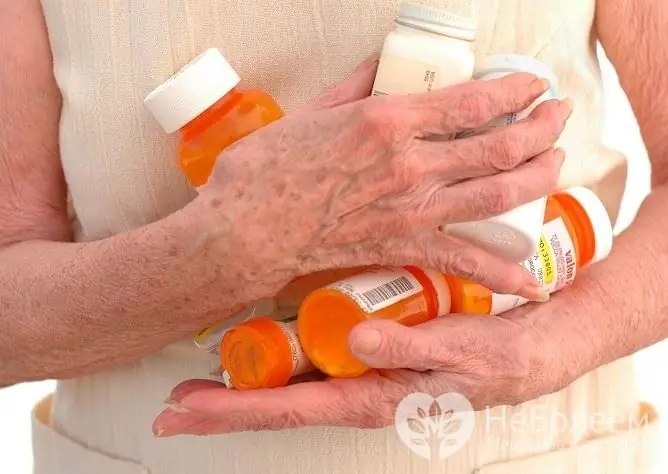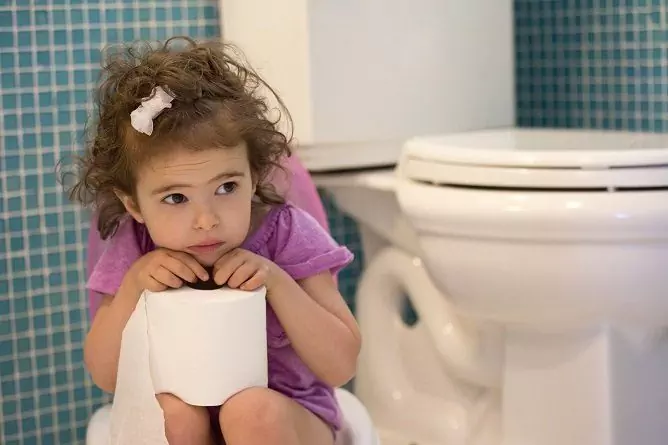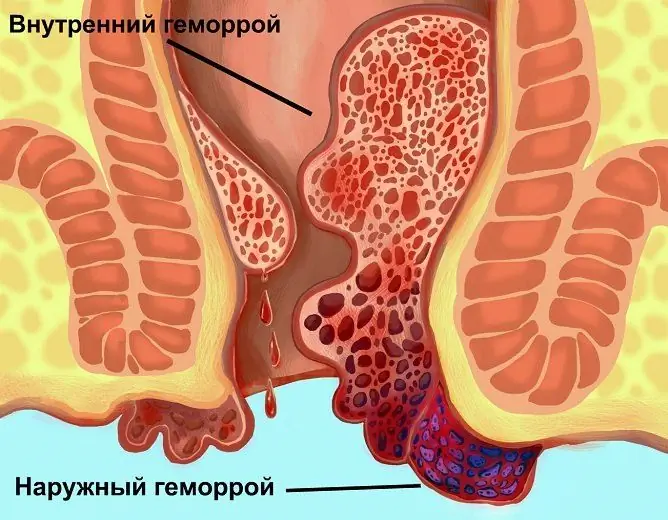- Author Rachel Wainwright [email protected].
- Public 2024-01-15 19:51.
- Last modified 2025-11-02 20:14.
Treating constipation in the elderly at home
The content of the article:
- Features of constipation in old age
- What to do with constipation: general principles and tips
- Diet
- Folk remedies for constipation in the elderly
- Laxatives
- Enema
- Exercises
- Video
Everyone can face constipation, but this problem is especially relevant for a child and an elderly person. Treatment of constipation in the elderly at home includes dietary adjustments, the use of herbs and medications, and lifestyle changes. Before treatment, it is imperative to identify the cause of the intestinal dysfunction.

It is possible to treat constipation in old age not only with the help of medicines, but also with the help of folk remedies, diet and exercise
Features of constipation in old age
Constipation is a violation of bowel movement, which is characterized by the following symptoms:
- there is an increase in the intervals between bowel movements (less than 1 time in 2-3 days);
- difficult bowel movement;
- feeling of incomplete bowel movement;
- the need for additional manipulations.
The development of constipation in old age is associated with many factors: slowing down of peristalsis, physical inactivity, a decrease in solid food in the diet, chronic diseases, and taking medications to treat major diseases.
The most common causes are:
- Eating disorders: insufficient intake of solid food, fiber, water.
- Changing the usual conditions. Often, reflex stool retention occurs when you change your place of residence (including hospitalization), climate, other conditions, under the influence of stress.
- Physical inactivity, prolonged bed rest.
- Diseases of the gastrointestinal tract: hemorrhoids, proctitis, colitis, rectal prolapse, anal fissure.
- Diseases of other organs. Endocrine disorders (hypothyroidism, diabetes mellitus), heart failure, and liver disease contribute to constipation.
- Side effects of drugs. Spasmolytics, muscle relaxants, bismuth preparations, antidepressants (Amitriptyline), diuretics can slow down bowel emptying.
- Tumor formations. The tumor leads to narrowing of the intestine, which is clinically manifested by stool retention.
This must be taken into account when determining treatment tactics. To combat constipation, it is not always enough to change the diet and take laxatives; it is imperative to identify the cause of the stool disorder.
What to do with constipation: general principles and tips
If the cause of constipation is not an organic disease, you can get rid of the symptom at home. Treatment is aimed at softening stool, increasing peristalsis and preventing the formation of fecal blockages. Complex treatment is used: diet, herbs, medications, enema.
To make your bowel movement easier, follow these simple tips:
- Drinking a glass of water immediately after waking up will help stimulate the bowels.
- Form a bowel movement mode - try to empty the intestines every day at a certain time.
- Drink more water throughout the day if there are no contraindications (edema, heart or kidney failure).
- Walk more, do light and simple exercises whenever possible.
- Before eating, do a gentle abdominal massage.
Diet
Diet plays an important role in preventing constipation. It is necessary to develop a diet: eat food at the same time, 5-6 times a day in small portions. It is not recommended to grind food, often prepare mashed potatoes and jelly. Products are best boiled or steamed.
From the diet, you need to exclude foods and drinks that slow down bowel movements and cause increased gas production:
- bread and pasta made from premium flour;
- rich pastries;
- rice and semolina porridge, lentils;
- smoked meats;
- strong tea, coffee and cocoa;
- whole milk;
- beans and peas.
Eating foods that stimulate peristalsis and provide a laxative effect will help fight constipation:
- Foods that contain a lot of fiber: beets, zucchini, carrots, cucumbers, pumpkin, apples, pears, apricots, plums, black currants, gooseberries.
- Buckwheat and oat groats, bread and pasta made from durum wheat, bran.
- Dried fruits: prunes, dried apricots, raisins, figs.
- Vegetable oils that improve intestinal motor activity: sunflower, olive, corn, linseed.
- Fermented milk products with a laxative effect: kefir, yogurt, fermented baked milk.
Folk remedies for constipation in the elderly
Folk recipes are often used to improve bowel function. The main ingredients can be herbs or foods that stimulate bowel movement. Folk remedies act mildly, rarely cause the development of side effects, which allows them to be taken for a long time.
5 best folk recipes for constipation:
| Name of funds | How to cook | How to use |
| Laxative paste |
What you need for cooking: 100 g dried apricots, 100 g prunes, 100 g raisins, 3 tablespoons of honey, lemon juice. Scroll dried fruits in a meat grinder or grind in a blender, add honey and lemon juice to them, mix thoroughly. |
Take 1 tablespoon on an empty stomach. |
| A mixture of kefir and buckwheat flour | Add 1 tablespoon of buckwheat flour to a glass of kefir, stir and leave overnight. | Drink the mixture on an empty stomach. |
| Flax seed infusion | Rinse 3 tablespoons of flax seeds with water, pour 1 glass of boiling water, leave overnight. | Take 1 tablespoon 30 minutes before meals. |
| Prune decoction | Rinse 100 g of prunes with water, pour 2 cups of boiling water, keep in a water bath for 15 minutes. | Take 50 ml 30 minutes before meals. |
| Decoction of senna, rhubarb and buckthorn |
For cooking you will need: 1 teaspoon rhubarb root, 1 teaspoon buckthorn bark, 1 teaspoon senna leaves, 1 cup boiling water. Mix the mixture, pour boiling water over, keep in a water bath for 15 minutes. |
Take 2 tablespoons before bed. |
Laxatives
Laxatives are an effective method for treating constipation, but you should always consult your doctor before using them. In older people, uncontrolled intake of laxatives can lead to addiction, dehydration, and impaired renal function.
The following drugs can treat constipation:
| Group name | Indications for use, features | Examples of |
| Osmotic laxatives |
They increase the volume of contents in the intestine. Lactulose-based preparations also colonize the intestines with normal microflora. Can be used for long-term treatment. |
Forlax, Lavacol, Normase, Duphalac, Dinolac. |
| Saline laxatives | Saline laxatives (magnesium sulfate, sodium sulfate) are often used as an emergency measure when urgent relief from constipation is needed. Not prescribed for long-term use. | Guttalax, Regulax. |
| Herbal preparations | Herbal preparations based on buckthorn, senna, rhubarb activate intestinal motility and inhibit the absorption of water in it. | Senade, Senadexin. |
| Preparations that soften stool | This group includes oils that can be taken orally or rectally. | Inside - castor, vaseline and almond oil. For rectal use, glycerin suppositories are prescribed. |

Senadexin is one of the most effective drugs used to treat constipation in the elderly
Enema
To set an enema, you will need an Esmarch mug, 1.5 liters of warm or cool water, petroleum jelly. Cool water is used to activate peristalsis, warm water to relieve spasms.
How to give an enema at home:
- Fill a mug with water.
- Lie on your left side, bend your right leg.
- Lubricate the tip with petroleum jelly, insert it into the rectum 3 cm.
- Open the hose, release the water.
- Empty your bowels.
Enema is a fast acting method, but there are limitations. It is not recommended to use an enema for long-term treatment, as it can damage the intestinal mucosa. In addition, its frequent use can be addictive, in which case the elderly person will not be able to empty the intestines on their own, without auxiliary manipulations.
Exercises
If organic pathology is excluded, special exercises can be used to treat constipation. Such exercises are aimed at strengthening the abdominal muscles, improving the blood supply to the internal organs.
| Initial position | How to do | |
| Standing, feet shoulder-width apart, hands at the waist. | Perform circular movements with your torso. | |
| Lying on your back. | Raise bent or straight legs. | |
| Lying on your back. | Perform circular movements with your feet, simulating cycling. |
Also, for the treatment and prevention of constipation, it is useful to walk more, swim, do yoga.
Video
We offer for viewing a video on the topic of the article.

Anna Kozlova Medical journalist About the author
Education: Rostov State Medical University, specialty "General Medicine".
Found a mistake in the text? Select it and press Ctrl + Enter.






